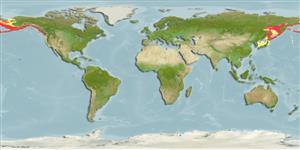分類 / Names
俗名 | 同種異名 | Catalog of Fishes(屬, 種) | ITIS | CoL | WoRMS | Cloffa
Teleostei >
Gadiformes (Cods)
鱈形目 (Cods) >
Gadidae (Cods and haddocks)
鱈科 (Cods and haddocks)
Etymology: Gadus: Latin, gadus = a fish, cod? (Ref. 45335); chalcogrammus: Name from the Greek 'chalcos' meaning brass and 'gramma' meaning mark (Ref. 6885).
More on author: Pallas.
Issue
This species is placed in the genus Gadus in Eschmeyer (CofF ver. Jan. 2012: Ref. 89336). More studies are needed for a complete revision of all genera of Gadidae.
Environment: milieu / climate zone / depth range / distribution range
生態學
海洋; 半鹹淡水 底中水層性; 非遷移的; 深度上下限 ? - 1280 m (Ref. 50550), usually 30 - 400 m (Ref. 54255). 極; 68°N - 34°N, 129°E - 120°W (Ref. 54255)
North Pacific: from Kivalina, Alaska, to the southern Sea of Japan and to Carmel, California, USA. The occurrence off the northern part of Baja California (Mexico), as reported from Quast and Hall, (1972) (Ref. 6876) is apparently erroneous.
北太平洋: 從 Kivalina ,阿拉斯加州, 到日本海南部與對卡梅爾,美國加州。 發生下加利福尼亞 (墨西哥) 的外海北部, 當記錄自 Quast 與門廳 @(1972)@(參考文獻 6876), 顯然錯誤。
Length at first maturity / 大小 / 重量 / 年齡
Maturity: Lm 36.9 range ? - ? cm
Max length : 91.0 cm TL 雄魚/尚未辨別雌雄; (Ref. 2850); 最大體重: 3.9 kg (Ref. 56335); 最大年齡: 28 年 (Ref. 55701)
背棘 (總數) : 0; 背的軟條 (總數) : 38 - 48; 臀棘: 0; 臀鰭軟條: 33 - 42. The dorsal fins are widely separated. The pelvic fins have a slightly elongated filament. The lateral line is continuous to about the back end of the first dorsal-fin base; it is interrupted at the read of the body. On the head are lateral line pores. Body color is olive green to brown on the back and becomes silvery on the sides and pale ventrally, often with mottled patterns or blotches.
背鰭是分開很遠的。 腹鰭些微地有一個瘦長的絲狀突起。 側線是到大約第一背鰭基底的背部末端的連續; 它在身體的閱讀被中斷。 在頭部上是側線孔。 體色是橄欖綠色的到褐色的在背部上而且側邊上變成銀色與腹側灰白的, 通常有有斑點的圖案或斑塊。
The adults usually live near to the sea floor, but sometimes they also appear near the surface (Ref. 1371). They perform diurnal vertical migrations (Ref. 1371). They mainly feed on krill (Ref. 39882) but they also eat fishes and crustaceans (Ref. 6885). The adults which are spawning are often solely captured for their roe (may have been the case in the first years of the fishery in the U.S., but hasn't been true for some time. In 1994, the North Pacific Fishery Management Council/NOAA enacted an amendment to the Bering Sea and Gulf of Alaska Fishery Management Plans effectively banning the practice of stripping roe and discarding the carcasses, R. Rogness, pers.comm. April 2022). The meat is used to produce surimi (this is an imitation of shellfish meat) (Ref. 28499). They are traded as fresh fish, boneless flesh, in frozen blocks or as surimi. The fish is cooked in the microwave, steamed or fried in butter (Ref. 9988).
成魚通常在到海洋底部的附近現場, 但是有時他們也出現接近水表面.(參考文獻 1371) 他們執行晝夜垂直迴游。 (參考文獻 1371) 他們主要地吃磷蝦 (參考文獻 39882) ,但是他們也吃魚與甲殼動物。 (參考文獻 6885) 成魚獨自地時常那是產卵為他們的魚白被捕獲。 魚白被用來生產魚肉醬 (這是一個貝肉的模仿).(參考文獻 28499) 他們被交易如新鮮的魚,無硬骨的肉,在冷凍魚塊中或如魚肉醬。 魚在在奶油被蒸或油炸的微波被煮。 (參考文獻 9988)
Life cycle and mating behavior
成熟度 | 繁殖 | 產卵場 | 卵 | 孕卵數 | 仔魚
Oviparous, sexes are separate (Ref. 205). Congregate in dense schools to spawn, usually at 50 to 250 m depth.北太平洋: 從 Kivalina ,阿拉斯加州, 到日本海南部與對卡梅爾,美國加州。 發生下加利福尼亞 (墨西哥) 的外海北部, 當記錄自 Quast 與門廳 @(1972)@(參考文獻 6876), 顯然錯誤。
Cohen, D.M., T. Inada, T. Iwamoto and N. Scialabba, 1990. FAO species catalogue. Vol. 10. Gadiform fishes of the world (Order Gadiformes). An annotated and illustrated catalogue of cods, hakes, grenadiers and other gadiform fishes known to date. FAO Fish. Synop. 125(10). Rome: FAO. 442 p. (Ref. 1371)
IUCN 瀕危狀態 (Ref. 130435: Version 2024-1)
人類使用
漁業: 高經濟性; 游釣魚種: 是的
工具
特別的報告
下載 XML
網路資源
Estimates based on models
Preferred temperature (Ref.
123201): 0.4 - 5.6, mean 1.6 °C (based on 444 cells).
Phylogenetic diversity index (Ref.
82804): PD
50 = 0.6250 [Uniqueness, from 0.5 = low to 2.0 = high].
Bayesian length-weight: a=0.00631 (0.00550 - 0.00724), b=3.03 (2.99 - 3.07), in cm total length, based on LWR estimates for this species (Ref.
93245).
營養階層 (Ref.
69278): 3.6 ±0.1 se; based on diet studies.
Generation time: 6.5 (3.6 - 7.8) years. Estimated as median ln(3)/K based on 25
growth studies.
回復力 (Ref.
120179): 低的, 最小族群倍增時間4.5 - 14 年 (Musick et al. 2000 (Ref.
36717); tmax = 28).
Prior r = 0.29, 95% CL = 0.19 - 0.44, Based on 16 full stock assessments.
Fishing Vulnerability (Ref.
59153): High vulnerability (59 of 100).
Climate Vulnerability (Ref.
125649): High vulnerability (55 of 100).
Nutrients (Ref.
124155): Calcium = 12 [8, 19] mg/100g; Iron = 0.185 [0.122, 0.296] mg/100g; Protein = 16.5 [15.1, 17.9] %; Omega3 = 0.337 [0.159, 0.741] g/100g; Selenium = 14.5 [5.7, 33.5] μg/100g; VitaminA = 11.2 [2.0, 57.3] μg/100g; Zinc = 0.445 [0.340, 0.563] mg/100g (wet weight); based on
nutrient studies.
